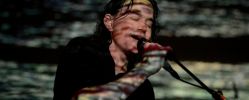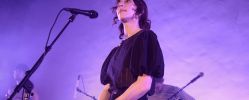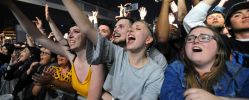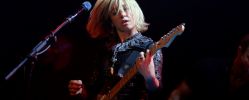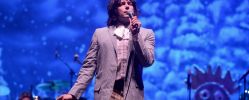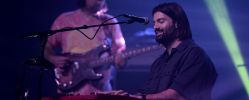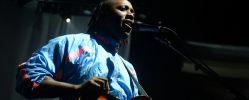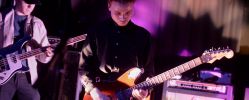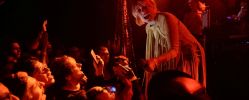
The Kan Zaman Can
KAN ZAMAN COMMUNITY ENSEMBLE
7.22.06
Barnsdall Arts Center/Hollywood
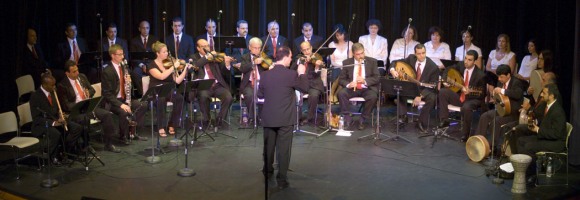
Not having, perhaps before Kan Zaman, an avenue to hear how Arabs kick it old school — and since every John Williams idol-snatching leitmotif should wither in caricature at the merest hint of authentic creativeness from the Middle East — let me put this into perspective. For July 22nd’s performance at the very plush Barnsdall Arts Center on Hollywood Boulevard, straws of passion broke every camel’s back for leagues in every direction. Egyptians kissed the cheeks of Lebanese and Syrians and Iraqis, and no one wore a goddamn fez. People clapped and wept in a language the enthusiastic expression of which makes most of you nervous. There was a welcome absence of jerks linking Arab tonality to bombs between the minarets. And at one point, when fifty-something Iraqi singer Saadoun al-Bayati took up the doumbek, some crazy Egyptian guy started screaming out “Aazama Aala Aazama!” at the top of his lungs — like, front row Metallic style, being all loud, shameless and into it. A nice man seated next to me translated: “You guys excel! You guys excel at all things! You are really awesome!” (No, it wasn’t “Death to America” or some shit on CNN, which is what I thought at first, not used to hearing Arabs go nuts over a drum solo — like it was even fucking possible. God, I am such an ignoramus.)
I don’t speak Arabic, so I couldn’t sing along with everyone else, or really appreciate the depth of these classics — I mean, these are some well-known songs for twenty-two countries filled with centuries of culture, with a potency that, at a guess, is like a cross between YANKEE DOODLE and ANARCHY IN THE UK. And I didn’t keep my flyer from the show, which is my bad. But dig if you will a picture of Director Wael Kakish at the head of a shock choir of handsomely-dressed men and women, conducting the works of Egyptian, Syrian, Turkish and Lebanese artists of the 19th and 20th centuries, astride a semi-circle of power talent, and behold a living legacy of traditional Arab music as it lives and breathes. There are annotations to Led Zeppelin’s KASHMIR that are deeper and spookier than anything Rudolf Valentino’s house composers ever dreamed up when the marquis referred to “the backward people of Araby living in happy ignorance”. The nearest footnote to Kan Zaman might be — might be — Fairuz, and ten splendiferous Arab points if you know who she is.
Now for a bonus round. See if you recognize the clarinet and cello in this instrumental run-down:
Afif Taian – ’ud
Alfred Madain – bendir
Allynne Perkins – bendir
David Mertinelli – riqq
Elias Thomas – Kaman
Faisal Zedan – darabukka
George Haddad – ’ud
Ghassan Tahan – Darabukka
Jim Sullivan – Bass & Turkish clarinet
Khaled Khalifa – cello
Maurice Saba – kaman
Musa Nasser – ’ud
Nabih Esmeirat – nay
Peter Refela – ’ud
Sako Sahagian – clarinet
Stephanie Koeshall – kaman
Thalia Goldsworthy – qanun
Victor Isaac – kaman
Ha ha ha! Let me tell you something. I laugh at you.
The ’Ud, or Aoud, is a kind of Arabic lute that is played at the traditional speed of a bird fluttering his wings so fast it keeps you focused on it without blinking. (Also in traditional style were the late-comers to the theater, who did not bother even to whisper as they haggled in the aisle over the seating while the irritated ’Udist performed a solo.) The doumbek and darabukka are Muslim drums. The kaman is a kind of sour-tempered violin at the heart of the sound. The nay is a six-holed flute usually performed wearing a fez and charming a cobra. The other instruments are beyond the office of description, but you are welcome to imagine djinnis in battleships of dandelion fluff and mothy reed instruments encouraging Tunisian brides to dance for their husbands.
As for the vocal performance, my darling Lebanese angel sings in Kan Zaman, so I admit to a bias. In this style of Arabic music, there are bell-weathered mathematical scansions that define the range of solo performance. The styles included in this concert were a lot of Muwashahat which mainly come from Syria. An Iranian vocalist got to my soul with his gentility and sadness. Sam the vocalist, who was part of the choir, sang a mawal that reminded me of the Islamic prayers “Adaan” you hear coming from the mosques in Lebanon. His nasaly vocal quality is what he had in common with a lot of the qur’aniq trained vocalists who recited prayers through maquams (different arabic scales). A mawal btw is an improvisational vocal piece, sometimes answered by the choir.
I don’t know what these guys were saying in their mawals but the audience rose up clapping and cheering whenever someone stepped up to the plate. You heard Sam’s voice break from passion when he was really on the money, and everyone went nuts appropriately. Also were elements of something like blues, a call-response between women and men that was mutually hypnotic. The deep eerie “don’t mess with Allah” feeling was in gypsy minor, a series of ascending progressions that added oil to the brazier. Most of the time, the men and women octavized their sound, moving in formation like the Blue Angels over the weaving 10/8 time
rhythm of Arabic tabla.
And that’s all the pop-music theory I can gush into words, and I know you would have been transported. I’m just trying to give our fair city a little credibility with the Arab Street.
See these guys if you get the inclination or the chance.
Yeslamo.
